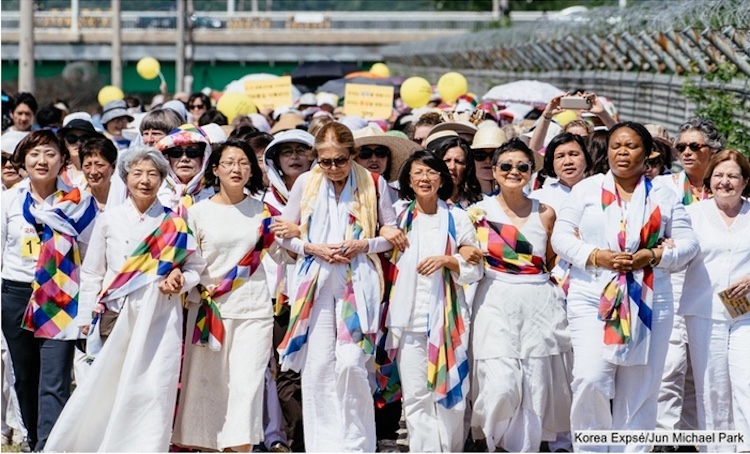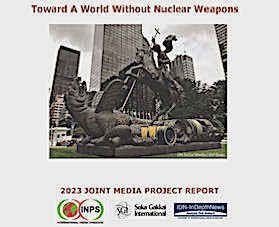Pursue Fresh Diplomatic Approaches, Not Military-Nuclear Posturing
Viewpoint by Dr Rebecca Johnson
LONDON (IDN) — Nuclear fears have been increasing in North-East Asia in recent months. From early November, North Korea ratcheted up its usual sabre rattling with more direct threats, ‘tactical nuclear drills’, apparent preparations for more nuclear tests, and by firing around 25 different missiles towards South Korea and Japan. [2022-11-15-19] CHINESE | JAPANESE TEXT VERSION PDF
Some of Pyongyang’s missiles reportedly landed much closer than usual to South Korea (around 25-60 km), provoking fear and anger. What is the context and what steps could dial down the tensions and stop nuclear weapons being used?
North Korea made clear that its missiles were launched in reaction to the Vigilant Storm military exercises planned and conducted by the United States and South Korea from October 31. Taking place over six days, these large-scale military exercises included over 1,600 sorties involving 240 warplanes, including nuclear-capable B-1B and F-35 stealth bombers near North Korea.
Unsurprisingly, Pyongyang objected, declaring that such “military rashness and provocation can be no longer tolerated”. Using similar language, South Korea’s Joint Chiefs of Staff objected to Pyongyang’s missile firings, saying “Our military can never tolerate North Korea’s provocative act and will sternly respond to it in close cooperation with the US”.
Accusing North Korea of having “unilaterally escalated its persistent provocations”, Japan’s defence minister Yasukazu Hamada said: “North Korea’s actions threaten the peace and security of our country, the region, and the international community, and are absolutely unacceptable.”
The rhetoric should not obscure the context. The legacies of Japan’s brutal occupation from 1910-45, the terrible impacts of the nuclear bombs that destroyed Hiroshima and Nagasaki, and the 1950s Korean war need to be recognised. US Senators lobbied Washington to use further nuclear weapons on Kim Il-sung’s North Korean troops.
The current leader, Kim Jong-un, is an insecure grandson of the dynasty, trying to control North Korea’s people through fear, patriotic appeals, nuclear myths and false promises. He was just twenty in 2002, when US President George W Bush’s ‘State of the Union’ speech lumped North Korea in with Iran and Iraq as an ‘axis of evil’—and then invaded non-nuclear Iraq, causing devastating humanitarian impacts that persist today.
For weak leaders, nuclear weapons appear attractive for power projection, freedom of action and regime survival. But nuclear weapons cannot feed people, unite divided families, or bring security.
The Korean War ended with forced separation and an uneasy armistice between the United States and North Korea. Separated by the ‘Demilitarized Zone’ (DMZ) along the 38th parallel, the Korean Peninsula got locked into a ‘forever war’, in which nuclear weapons became a growing part of the political deadlock between Washington and the Kim dynasty.
In May 2018, after the Treaty on the Prohibition of Nuclear Weapons (TPNW) was negotiated and adopted by the United Nations in 2017, I was honoured to participate with Korean women, activists and Nobel laureates in ‘Women Cross DMZ’ peace demonstrations in Seoul.
While we were there, Donald Trump petulantly pulled out of his planned meetings with Kim Jong-un in Singapore. Over 6,000 of us walked across the ‘Reunification Bridge on May 24 and ate together with North Korean women.
Our main calls were for a genuine peace treaty for the Korean peninsula that recognised shared interests in building security and peace, along with development aid for the North and the lifting of political-military barriers to enable divided families to become reconnected. On re-entering South Korea, we heard on the news that South Korea’s President Moon Jae-in had met Kim Jong-un just a few miles from us in the DMZ.
The optimism generated by their peace talks was unfortunately short lived. Kim wanted the US president’s flattering attention more than serious talks with the North-Korean born South Korean president. Lessons can be learned, however.
For all Donald Trump’s many flaws, his transactional approach offered an innovative way to engage Kim Jong-un. Within months, Trump got offended about some real or imagined slight and the two inadequate US-North Korean leaders resumed trading ‘mine is bigger than yours’ nuclear threats, with Kim Jong-un, doing his mini-me macho best to compete.
A major obstacle to the sensible proposals from women on all sides is the long-standing, intransigent and—let’s be honest—failed US mantra of ‘complete, verifiable, irreversible denuclearization’ (CVID in diplomatic jargon). The pious US insistence on the CVID dogma had stalemated years of ‘Six Party Talks’ involving North and South Korea, the United States, China, Japan and Russia.
Of course, getting rid of nuclear weapons is essential for sustainable security for the whole world—that’s why most UN member states now support the TPNW, which entered into international legal force in 2021. To move forward in Korea, something else needs to happen first.
Denuclearizing North Korea cannot be just a finger-pointing exercise; it has to be done in the context of negotiations to demilitarize and denuclearize the whole Korean Peninsula and its surrounding islands and seas.
Kim’s toolbox has little to offer, as relations between Russia, China and the United States fluctuate uneasily. Pyongyang is reportedly selling artillery and shells to replenish depleted Kremlin stocks as Russia becomes increasingly bogged down in Ukraine.
Nonetheless Kim, like Putin, is capable of escalating nuclear threats into attacks. And let's be clear, there is no such thing as a tactical nuclear attack: Any nuclear use would be strategically intended, and have appalling strategic consequences.
As first steps, pay attention to the demands and experience of Korean women from North and South. All sides need to engage more constructively in regional negotiations on peace and denuclearization without preconditions.
Utilizing the TPNW’s growing tools for implementing nuclear disarmament and verification will also open up ways for the governments and people to rethink national security and start denuclearizing all of the threatening regimes and arsenals.
*Dr Rebecca Johnson is a nuclear analyst and peace activist who participated in negotiations on the 1996 Comprehensive Test Ban Treaty and the 2017 Treaty on the Prohibition of Nuclear Weapons (TPNW), becoming first president of the International Campaign to Abolish Nuclear Weapons in 2010. [IDN-InDepthNews — 15 November 2022]
Photo: A Group of 'Women Cross Demilitarised Zone (DMZ)'













